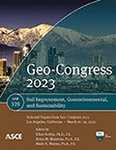Analysis of Pervious Oyster Shell Habitat (POSH) Unit Effectiveness Using Computational Fluid Dynamics (CFD) and Field Observations
Publication: Geo-Congress 2023
ABSTRACT
Pervious oyster shell habitat (POSH) units are a novel method for oyster reef restoration and shoreline protection. POSH units have a similar function to traditional reef balls but are constructed from recycled oyster shells and cement. So far, POSH units have been deployed at multiple sites in Northeast Florida, including Kingsley Plantation, which is part of the Timucuan Ecological and Historic Preserve. The function of the POSH units at the Kingsley Plantation research site is to promote oyster growth/recruitment and attenuate wave energy from boat wakes in effort to mitigate shoreline erosion. The purpose of this study was to utilize computational fluid dynamics (CFD), specifically Siemens’ STAR-CCM+, to examine the effectiveness of the POSH units at reducing shoreline bed stress at the research site. A model with a single POSH unit was created and run under two wave scenarios. Results indicated that a single POSH unit may reduce bed stress, but this reduction is likely minimal. However, secondary effects that may influence shoreline erosion were also observed. These effects will be explored in future research. In addition, the CFD procedure outlined in this study may be used with multiple POSH unit configurations in the future to assess overall effectiveness.
Get full access to this article
View all available purchase options and get full access to this chapter.
REFERENCES
Androulakis, D. N., Dounas, C. G., Banks, A. C., Magoulas, A. N., and Margaris, D. P. (2020). “An assessment of computational fluid dynamics as a tool to aid the design of the HCMR-artificial-reefsTM diving oasis in the underwater biotechnological park of Crete.” Sustainability., 12 (12), 4847.
ASTM. (2001). Standard Test Method for Sieve Analysis of Fine and Coarse Aggregates (C136-01), ASTM, West Conshohocken, PA.
ASTM. (2006). Standard Practice for Classification of Soils for Engineering Purposes (Unified Soil Classification System) (D2487-06), ASTM, West Conshohocken, PA.
Beck, M. W., et al. (2011). “Oyster reefs at risk and recommendations for conservation, restoration, and management.” BioScience., 61 (2), 107–16.
Breuer, M., Jovičić, N., and Mazaev, K. (2003). “Comparison of DES, RANS and LES for the separated flow around a flat plate at high incidence.” Int. J. Numer. Methods Fluids., 41 (4), 357–88.
Forlini, C., Qayyum, R., Malej, M., Lam, M.-A. Y.-H., Shi, F., Angelini, C., and Sheremet, A. (2021). “On the problem of modeling the boat wake climate: The Florida Intracoastal Waterway.” J. Geophys. Res.: Oceans., 126 (2), e2020JC016676.
Google Earth Pro and TerraMetrics. (2022). <https://www.google.com/earth/versions/>(Oct. 4, 2022).
Maslov, D., Johnson, J., Pereira, E., Duarte, D., Miranda, T., Lima, M., Cruz, F., Valente, I., and Pinheiro, M. (2019). “Experimental testing and CFD modelling for prototype design of innovative artificial reef structures.” In OCEANS 2019, Marseille: (pp. 1–7). IEEE.
Morris, R. L., et al. (2019). “The application of oyster reefs in shoreline protection: Are we over‐engineering for an ecosystem engineer?.” J. Appl. Ecol., 56 (7), 1703–11.
Nicoud, F., and Ducros, F. (1999). “Subgrid-Scale Stress Modeling Based on the Square of the Velocity Gradient Tensor.” Flow, Turbulence, and Combustion., 62, 183–200.
Radabaugh, K. R., Powell, C. E., and Moyer, R. P. (2017). “Coastal Habitat Integrated Mapping and Monitoring Program Report for the State of Florida.” Florida Fish and Wildlife Conservation Commission, Fish and Wildlife Research Institute.
Rodriguez, A. B., et al. (2014). “Oyster reefs can outpace sea-level rise.” Nat. Clim. Change., 4 (6), 493–7.
Safak, I., et al. (2020). “Coupling breakwalls with oyster restoration structures enhances living shoreline performance along energetic shorelines.” Ecol. Eng., 158, 106071.
Shafer, D. J., Roland, R., and Douglass, S. L. (2003). “Preliminary evaluation of critical wave energy thresholds at natural and created coastal wetlands.”.
Shields, A. (1936). Application of similarity principles and turbulence research to bed-load movement. California Institute of Technology, Pasadena (Translated from German).
Siemens. (2021). Simcenter STAR-CCM+ User Guide. Siemens.
Uddin, M. J., Smith, K. J., and Hargis, C. W. (2021). “Development of pervious oyster shell habitat (POSH) concrete for reef restoration and living shorelines.” Constr. Build. Mater., 295, 123685.
Information & Authors
Information
Published In
History
Published online: Mar 23, 2023
Authors
Metrics & Citations
Metrics
Citations
Download citation
If you have the appropriate software installed, you can download article citation data to the citation manager of your choice. Simply select your manager software from the list below and click Download.
